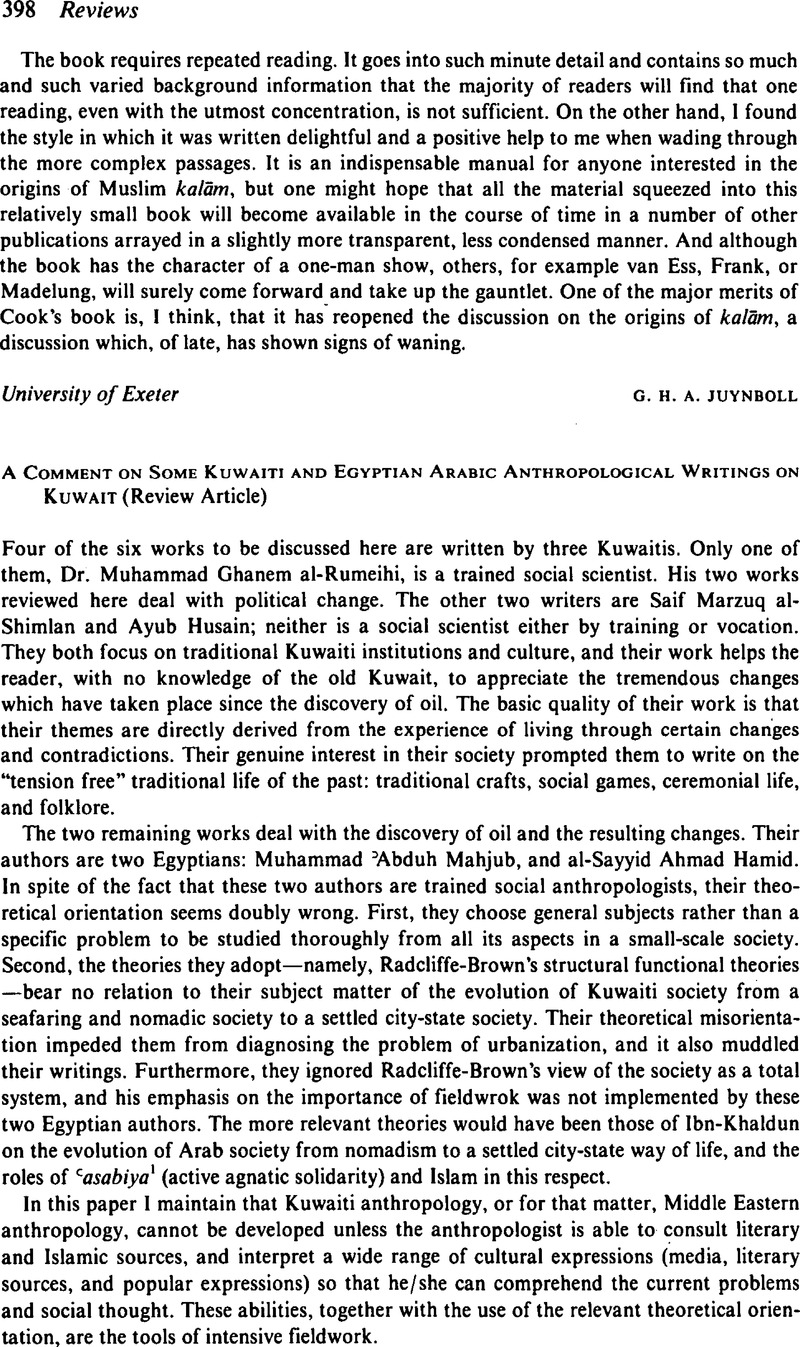No CrossRef data available.
Published online by Cambridge University Press: 29 January 2009

Author's note: I would like to thank Dr. John Beattie, and the late Mr. Thomas Hodgkin for reading an earlier version of this paper in the summer of 1979. The paper was also read at the Dept. of History, Simon Fraser University, B.C., Canada in the autumn of 1979. I thank Dr. J. Spagnolo for his valuable comments. I am also indebted to Dr. D. Hopwood for information on Ibn-Miskawayh, and for reading my notes. The books reviewed here were chosen because they were given or recommended to me by colleagues with whom I worked at Kuwait University, Dept. of Sociology and Social Work (September 1977–February 1978), or were loaned to me by my Kuwaiti students, in particular, Nadia S⊂ad al-Kharji.Google Scholar
1 Beeston, A. F. L., Emeritus Professor of Arabic at Oxford University, informs me that Ibn-Khaldun invented the word 'asabiya to denote agnatic solidarity, and alliance between a dominant tribe and its clients (mawāli). Mr. Albert Hourani interprets the complex concept of 'asabiya as follows: it implies conscious active solidarity expressed in terms of agnatic solidarity, and directed towards the creation of collective power, and the acquisition of political authority. Throughout this work the Arabic word 'asabiya is used instead of inadequate English translations.Google Scholar
2 al-Shimlan, Saif Marzuq, Tārīkh al-Ghaws 'ala alu' lu' fi al-Kuwair wa al-khalīj al'Arabi, Vol. 1 (Matba'at Hukumat al-Kuwait: Kuwait, 1975), pp. 86–87.Google Scholar
3 Ibid., pp. 13, 22.
4 Ibid., p. 119.
5 Ibid., pp. 358–359, 391, 441.
6 Lorimer, J. G., Gazeteer of the Persian Gulf. Oman and Central Arabia (Calcutta, 1908–1915; reprinted Farnborough in 1970)Google Scholar, Al-Shimlan refers to an Arabic translation, but the names of the translator and publishers, as well as the date of publication, are not given. Al-Shimlan, Tārīkh al-Ghaws, Vol. 1, p. 337.Google Scholar
7 Ibid., pp. 150–153, 253, 281.
8 Husain, Ayub, Ma'a Dhikrayātina al-Kuwaitiya (Matba'at Hukumat al-Kuwait: Kuwait, 1972).Google Scholar
9 Ibid., p. 13. 'Awra refers to the private parts. It also indicates the weakness which makes a thing vulnerable, for instance, a house is cawra if it is vulnerable to thieves. See Abu-Zahra, Nadia, “Bearaka, Material Power, Honour, and Women in Tunisia,” Revue d'Histoire Maghrebine (Tunis: 01 1978), pp. 8–10.Google Scholar
10 I was told by my students that upper-class Kuwaitis do not engage in agriculture.Google Scholar
11 Husain, Ma'a Dhikrayatina, pp. 199–278.Google Scholar
12 al-Rumeihi, Muhammad Ghanem, al-Judhūr al-Ijtimā'iya lil-Dimuqratiya fi Mujtama⊂ at al-Khalīj al-'Arabi al-Mu'āsira (Dar al-Siyasa: Kuwait, 1977).Google Scholar
13 Ibid., p. 12.
14 Ibid., p. 21.
15 Lienhardt, Peter A., “Some Social Aspects of the Trucial States” in Hopwood, Derek, ed., The Arabian Peninsula Society and Politics (George Allen & Unwin: London, 1972), p. 226.Google Scholar See also Abu-Hakima, A. H., “The Development of the Gulf States”Google Scholaribid., p. 34; and idem.Tārīkh Sharqi al-Jazīra al-'Ara-biya (Cairo, 1968), pp. 74–75.Google Scholar
16 On 24 February 1981, a national assembly was elected in Kuwait. None of the candidates with progressive political ideas or those of nationalistic tendencies was elected. See Le Monde and the Guardian, 26 February 1981.Google Scholar
17 Al-Rumeihi, al-Judhūr, pp. 33–36, 46.Google Scholar
18 al-Rumeihi, Muhammad Ghanem, al-Bitrul wa al-Taghayyur. al-Ijtima'i fi al-Khalij al-Arabi, (Ma'had al Buhuth wa al-Dirasāt al-'Arabiya: Cairo, 1975).Google Scholar
19 Ibid., p. 122.
20 Ibid., pp. 37–41.
21 Ibid., pp. 66–69, 83–119.
22 Mahjub, Muhammad 'Abduh, al-Hijra wa al-Taghayyur al-Binā⊂ī fī al-Mujtama' al-Kuwaiti. Dirāsa fī al-anthurubulijiya al-Ijtima'iya (Kuwait, n.d.).Google Scholar
23 Ibid., pp. 5–6, 20, 31–34, 65, 81, 332–333.
24 Hamid, al-Sayyid Ahmad, al-Fintās, Dawlat al-Kuwait, Dirāsa fī al-Tamasuk al-Ijtima 'ī fī Mujtama' Mutaghayyir (Alexandria, n.d.).Google Scholar
25 Ibid., p. 44.
26 Bourdieu, Pierre, The Algerians, translated from the French by Ross, C. M. (Beacon Press: Boston, 1962), p. 12.Google Scholar
27 Hamid, al-Fintās, p. 128.Google Scholar
28 Ibid., p. 129.
29 Abu-Zeid, Ahmad, al-Anthurubulujiya al-Ijtima'iya (Alexandria, 1960), translated from English into Arabic of the late Sir Evans-Pritchard's, Edward Social Anthropology (Oxford University Press: Oxford, 1951).Google Scholar
30 al-Isfahani, al-Raghib, Mujma' Mufradāt Alfāz al-Qur'can, Marcashli, Najib, ed., (Dar al-Katib al-'Arabi: n.pl., 1972), p. 340.Google Scholar
31 The Holy Qur'ān, IX:97, 100 and XLIX:13.Google Scholar
32 al-Rihani, Amin, Mulūk al-'Arab, 4th ed. (Dar al-Rihani lil-Tibā'a wa al-Nashr: Beirut, 1960), pp. 5, 28–29.Google Scholar
33 Mahjub, al-Hijra, p. 279;Google ScholarHamid, al-Fintās, p. 131.Google Scholar
34 In spoken Kuwaiti Arabic the Jim is pronounced as Ya.
35 Al-Hukuma, al-Kuwaitiya, al-Kuwait at-Yaum (Kuwait, 14 12 1959).Google Scholar
36 See al-Siyāsa, a daily newspaper in Kuwait, issues of 25 November 1977.Google Scholar
37 Ibid., 9 and 29 November and 10 December 1977.
38 al-Qaddus, Ihsan 'Abd, Arjūka Khudhnī min hadhā al-Barmīl (al-Hay'a al-Misriya al-'Amma lil-Kitab: Cairo, 1977), p. 200.Google Scholar
39 Mahmūd, Zaki Najib, Tajdīd al-Fikr al-'Arabi (Dar al-Shurūq: Beirut, 1971).Google Scholar
40 Wahba, Hafiz, Khamsūna 'Ama fī Jazīrat al-'Arab (Maktabat al-Babi al-Halabi: Cairo, 1960), pp. 1–21.Google Scholar
41 Bourdieu, Pierre, “Systems of Education and Systems of Thought,” in Young, Michael F. D., ed., Knowledge and Control (Collier-Macmillan: New York, 1971), pp. 200–201.Google Scholar
42 Shukri, Ghāli, Mudhakkirāt Thaqāfa Tahtadir (Dar al-Tali'a: Beirut, 1977), p. 11.Google Scholar
43 Said, Edward, Orientalism (Pantheon Books: New York, 1978), p. 186.Google Scholar
44 Lane, Edward William, An Account of Manners and Customs of Modern Egyptians, 2 vols., (London, 1836), Vol. I, pp. 207, 240, Vol. II, pp. 61–62, 269–270.Google Scholar
45 al-Qaddūs, Ihsān 'Abd, al-Rāqisa wa al-Siyāsi (al-Hay'a al-Misriya al-'Amma lil-Kitab: Cairo, 1978).Google Scholar
46 Berque, Jacques, Cultural Expressions in Arab Society Today, translated from the French by Stookey, R. W. (University of Texas Press: Austin, 1978), p. 19.Google Scholar In French, it appeared under the title Langages Arabes Du Présent (Editions Gallimard: Paris, 1974).Google Scholar
47 One example of this character's exaggerated lies was that when he (Abu-Lam'a al-Asli) visited the president of the U.S.A., wherever they appeared in public—with Abu-Lam'a wearing his striped garment (jallabiya)—all Americans pointed to them, asking “Who is the man with Abu-Lam⊂a?”Google Scholar